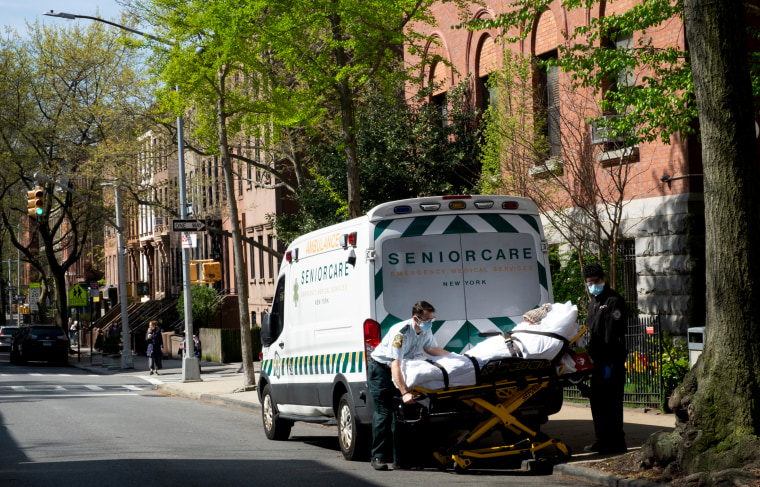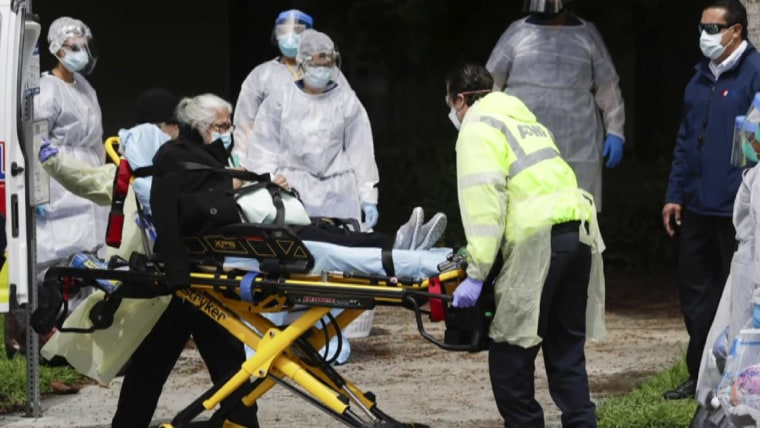By Suzy Khimm and Laura Strickler,
WASHINGTON — Three months after the coronavirus began rampaging through U.S. nursing homes, the federal government has released the first nationwide data on the virus' impact on long-term care facilities, showing nearly 26,000 resident deaths and 449 staff deaths to date.
But the figures released Monday are significantly lower than other estimates, as they capture only a part of total coronavirus deaths associated with nursing homes. The federal government is not requiring facilities to report data on cases or deaths that happened before May, and the administration said nearly 3,000 nursing homes have yet to submit data to the government.
According to the latest NBC News tally, nearly 40,000 coronavirus deaths are associated with nursing homes, assisted living and other long-term care facilities since the beginning of the pandemic — representing almost 40 percent of all coronavirus deaths in the U.S. The NBC News tally is also likely to be an undercount, as a handful of states have still not released their nursing home death tolls.
The Trump administration acknowledged the steep toll the virus has had on nursing homes, with more than 60,000 coronavirus cases among nursing home residents and nearly 35,000 cases among staff members in the facilities that reported data.
About 1 in 4 nursing homes have had at least one COVID-19 case, and 1 in 5 had at least one death related to the virus, the Centers for Medicare & Medicaid Services, or CMS, said in a statement.
"This data, and anecdotal reports across the country, clearly show that nursing homes have been devastated by the virus," Dr. Robert Redfield, director of the Centers for Disease Control and Prevention, and Seema Verma, administrator of the CMS, wrote in a letter to governors.
Full coverage of the coronavirus outbreak
The newly released data include responses from about 12,500 nursing homes, representing 80 percent of the total number of facilities, the CMS said. Nursing homes are not required to report deaths or cases that occurred before May. The administration noted that some facilities may have chosen to include earlier deaths, but it did not specify how many did so.
The data did not include information from assisted living facilities, as they are not federally regulated.
The CMS did not immediately respond to a request for comment for this report.
May 13: Nursing homes plead for more tests, protective equipment
MAY 13, 202004:50
"We don't have any information to really tell us where did this emerge, what was effective in controlling it and what wasn't effective," he said.
Sen. Bob Casey of Pennsylvania, the ranking Democrat on the Special Committee on Aging, said in a statement: "The Trump administration has failed the more than 40,000 Americans in long-term care settings who have lost their lives to COVID-19. The families who lost a loved one prior to May 1 deserve a basic level of respect and their loved ones should be counted."
The Trump administration also announced that it would be increasing penalties for nursing homes that fail to comply with federal infection control requirements. The administration would also be tying federal funding to the completion of infection control surveys of nursing homes, which states are responsible for carrying out.
The CMS will be posting data reported by individual nursing homes on its website this week, the agency said, and the data will be updated weekly.
Nursing homes must still report outbreaks to state health departments, but there are major gaps in the state data, as well. In Texas, for example, residents' deaths are linked to nursing homes only if they happen in the facilities or within 24 hours of the patient's having been admitted to a hospital, according to the state health department. Oregon includes all hospital deaths of nursing home residents in its tally of deaths associated with long-term care facilities.
But Oregon is no longer posting the cumulative death toll for nursing homes — only deaths related to facilities that have current outbreaks. In Michigan, where at least 5,000 nursing home residents have contracted the virus, state officials say they are still validating the death tolls that facilities have reported to them. And Missouri told NBC News that it is still not tracking nursing home deaths.

The CDC has periodically asked states to pass on the data they have collected on nursing home deaths since the beginning of the pandemic. But the federal government has never formally asked states to submit the data, and only some of them did, state officials told NBC News.
The nursing home industry called for more federal and state resources to help facilities combat the pandemic and criticized the CMS for imposing greater penalties.
"Today's data are a grim reminder of a slow-motion tragedy that could have been averted if our federal and state governments had stepped up to provide the leadership, coordination and funds that nursing homes need to save lives," said Katie Smith Sloan, president and CEO of LeadingAge, which represents nonprofit long-term care providers. "Today's CMS action offers no support. Instead it seeks to punish its way out of the pandemic."
The Trump administration announced in early May that it would be sending two weeks' worth of personal protective equipment to every nursing home in the U.S., coordinated by the Federal Emergency Management Agency and divided into two shipments.
As of Monday, less than half of the country's nursing homes had received a single shipment, according to figures provided by FEMA.



